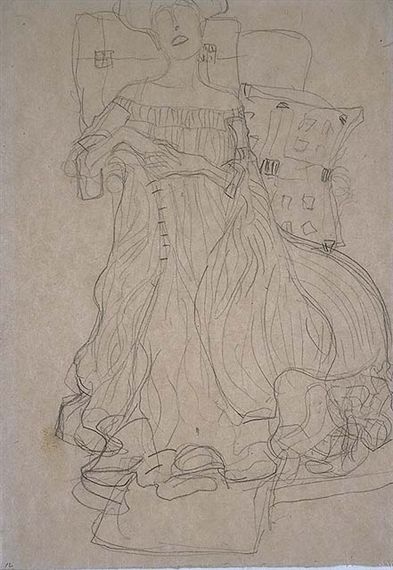KLIMTS IN CANADA— A NAZI-ERA ART CRIME RESOLVED
Posted by Deirdre | Filed under Blog

I just watched Woman in Gold, the 2015 film about how Gustav Klimt’s magnificent gold-leaf portrait of Adele Bloch-Bauer was returned to her only surviving heir following its theft by the Nazis, and was transported back to when I was reporting on art restitution cases for The Globe and Mail. I had corresponded with Randolph Schoenberg, the lawyer who assisted Maria Altmann in getting the painting of her late aunt out of Vienna’s Belvedere museum and into her rightful hands, when I discovered that there were other descendants of the esteemed Bloch-Bauer living here in Canada. Schoenberg was then fighting the government of Austria on behalf of Altmann, like him a resident of Los Angeles of Austrian descent, and so was busy. Yet, he readily made himself available to me, sharing documents and knowledge. I had to watch the film to realize, belatedly, that he is the grandson of Arnold Schoenberg, the celebrated 20th century composer who developed the 12-tone method of composition. I assumed from his sage demeanour— we corresponded via phone and email— he was an older man, not the young whip depicted in the film. Canadian actor Ryan Reynolds plays him, by the way. Helen Mirren is Maria. But back to real-life.

After watching on screen a case I knew so well, I typed my name and Klimt into Google to see if one of my old stories might pop up, and there it was, the one I was just talking about — concerning other Bloch-Bauer descendants, Klimt, and a couple of Canadian art museums. Maybe this is the sequel film. I’d write that script anytime. My investigative reporting on Nazi-era art heists was among the most fascinating period of my career. I did many more stories, but let’s start with this one:

Masterpiece drawings by Austrian Secessionist movement artist Gustav Klimt that were plundered by the Nazis are now in Canada as a result of a successful claim by the Canadian heirs of the works’ Jewish owners.
Some of the drawings, all studies for Klimt’s sumptuous 1907 portrait of Adele Bloch-Bauer, said to be the highlight of the Viennese painter’s golden period, will go on display in June as part of a Klimt exhibition organized by the National Gallery of Canada.
It will be the first Canadian showing of the works, which entered the country in the summer after descendants of the once-prominent Bloch-Bauer family of Vienna repatriated them from an Austrian gallery, The Globe and Mail has learned.
Eight are in Canada, and their presence is another side of the Holocaust-era art story — what happens to the work once reclaimed by its legal heirs.
In the case of the Klimt drawings, four pieces returned to Francis Gutmann of Montreal are designated for public viewing.
Mr. Gutmann’s late mother was a Bloch-Bauer, and the subject of Klimt’s studies was his great-aunt.
Mr. Gutmann sold two of the drawings to the National Gallery in November and another to Queen’s University in Kingston.
“I feel very strongly that these things should be seen,” Mr. Gutmann said in an interview yesterday. “I don’t think that they should stay in my living room.”
Four other drawings from the same collection went to Mr. Gutmann’s sister in Vancouver, while another grouping went to Maria Altmann, his aunt in Los Angeles. Mrs. Altmann, at 84 the only living Bloch-Bauer, is embroiled in her own lawsuit against the Austrian government for repatriation of six Klimt paintings.
She has sold her share of the drawings to a New York dealer, who has since resold them to a private collector. Mrs. Altmann told The Globe that each drawing is worth $20,000 (U.S.).
“These drawings are worth quite a lot,” Mr. Gutmann said. “The Austrians didn’t keep them for nothing all these years.”
Until recently, they were housed in the Albertina, one of Vienna’s finest art galleries. They entered that collection shortly after Germany absorbed Austria in 1938.
The Nazis stole them directly from the palatial Bloch-Bauer residence in central Vienna.
Nazi officials kept some of the looted treasures for themselves. Others they handed over to musems like the Albertina.
After the war, the Austrian government used some of the illicitly gained art as barter, selling and exchanging pieces for works of greater value.
Up for trade were several of the Bloch-Bauer drawings, with the exception being a core group of 16 deemed of extraordinary quality and value.
But a few months ago a bill was passed in Austria that now views partial restitution as unlawful.
“That’s how we finally got the drawings out,” Mr. Gutmann said. “The Austrian government now sees it as an illegal way of proceeding, of letting some things out and keeping other works behind.”
A 67-year-old physicist who teaches science at a Montreal college, Mr. Gutmann does not feel an emotional attachment to the artworks. But, he says, “I felt that Canada has been very good to me,” said Mr. Gutmann, a native of Austria. “I’d like the drawings to stay here.”
